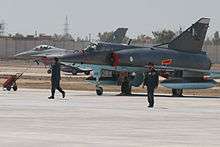No. 5 Squadron (Pakistan Air Force)
| No. 5 Squadron Falcons | |
|---|---|
| Active | 15 August 1947 — Present |
| Country |
|
| Allegiance |
|
| Branch |
|
| Type | Fighter squadron |
| Role | Multi-role |
| Mascot(s) | A falcon in flight carrying a weapon. |
| Aircraft |
F-16 Fighting Falcon F-16C/D Block 52+ |
| Engagements |
1947 Indo-Pak War 1965 Indo-Pak War 1971 Indo-Pak War |
| Commanders | |
| Notable commanders | Wing Commander Hakimullah |
| Aircraft flown | |
| Fighter |
Hawker Tempest II Hawker Fury F-86 Sabre Dassault Mirage III F-16C/D Block 52+ (2010-Present) |
| Reconnaissance | Dassault Mirage III RP (1967-2010) |
No. 5 Squadron, named the Falcons, is a Pakistan Air Force fighter squadron, the second oldest fighter squadron since the PAF's creation in 1947.
History


The squadron was established as part of the Royal Pakistan Air Force on 15 August 1947, equipped with eight Hawker Tempest II fighters and commanded by Squadron Leader Zaheer Ahmad. The unit was based at Miranshah and was suffering from inadequate numbers of technical staff. Most of the squadron's personnel were inherited from the Royal Indian Air Force No. 1 Squadron. In December 1947 the squadron provided cover to the Pakistan Army units pulling out from Razmak during 'Operation Curzon.'
In the early 1950s the unit was converted to fly the Hawker Fury.
On 1 September 1965, just prior to the beginning of the 1965 Indo-Pak War, the squadron shot down four Indian Air Force de Havilland Vampires. During that war the unit flew 190 hours of sorties, including a strike on an Indian airbase during which Squadron Leader Safraz A. Rafiqui downed an Indian Hawker Hunter and two Vampires before being shot down himself. One of his wingmen, Flight Lieutenant Yunus Hussain, was also shot down after downing an Indian Hunter. Other kills include an EE Canberra and two Hunters shot down by Flight Lieutenant Cecil Chaudhry as well as one Dassault Mystere downed by Flight Lieutenant A. H. Malik.
The squadron's F-86 Sabres were replaced in 1967 with the Dassault Mirage IIIE and its role changed to tactical attack. The unit was made fully operational and, during the 1971 Indo-Pak War, over 200 missions were flown in day and night. Photo reconnaissance, counter air, air defence and interdiction sorties were carried out with first strikes targeting the Indian Air Force airbases at Pathankot and Awantipura. One EE Canberra was downed during a night-time intercept by Flight Lieutenant Naeem Atta and a Sukhoi Su-7 was damaged by Flight Lieutenant Riaz Sheikh.
The squadron's reconnaissance role is performed year-round along the entire eastern border with Mirage III/5 reconnaissance variants and reconnaissance pods supported by other PAF aircraft and ground-based radars. These duties require the squadron to be split up and deployed at different locations throughout the year. Reconnaissance duties are in addition to monthly Air Defence Alert (ADA) and training.
In 2010 the squadron was re-equipped with the F-16C/D Block 52+, the old Mirage III/5 being transferred to other units. As well as air-to-air and air-to-ground armaments such as the AIM-120 AMRAAM, the new F-16s are also equipped with new Goodrich DB-110 reconnaissance pods. These have seen service in the skies over North West Pakistan against the insurgency there, providing high resolution infra-red imagery and maps to the Pakistani forces.
| No. 5 Squadron Falcons | |||
|---|---|---|---|
| Role | Operational | Aircraft | Notes |
| 1947~1950s | Hawker Tempest II | ||
| ~1950s—---- | Hawker Fury | ||
| ----—1967 | F-86 Sabre | ||
| Tactical attack and reconnaissance | 1967—2010 | Dassault Mirage III | Operated four variants of the Mirage III/5 during the 1990s. Trans-frontier reconnaissance sorties with reconnaissance pods flown throughout the year in peace-time, supported by other equipment such as electronic warfare aircraft of No. 24 Blinders squadron. |
| Multi-role | 2010 | F-16 Fighting Falcon F-16C/D Block 52+ |
|
Awards
- Inter-Squadron Armament Trophy 1952
- Inter-Squadron Maintenance Efficiency Trophy (1991, 1992, 1995)
- Inter-Squadron Armament Competition (ISAC) 1996 - fourth place overall.
